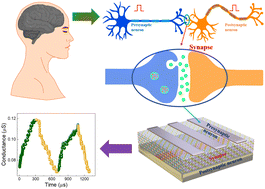Non-volatile memristor-based artificial synaptic behavior of redox-active organic composites†
Abstract
Cost-effectiveness, easy scalability and a simple fabrication process make the organic molecule-based resistive memory a very promising technology for new-generation data storage devices. With data storage, resistive memory has the capability of mimicking the biological brain and performing in-memory computing. This attracts researchers to study resistive memory devices. In this study, we have fabricated a small organic molecule trimesic acid (TMA) and poly(4-vinylpyridine) (PVP) composite-based resistive memory device. It shows excellent resistive switching with a high on–off ratio, great stability and data storage capability. Pulse transient measurements on the device demonstrated the capability of neuromorphic computation. The gradual set and reset process and change of conductance with an applied pulse confirmed the neuromorphic application. Paired pulse facilitation shows that the device can behave like the human brain. The redox active molecule and its change in conformation are the reasons for the switching behaviour of the device that led to the neuromorphic application of the device.

- This article is part of the themed collection: #MyFirstJMCC


 Please wait while we load your content...
Please wait while we load your content...